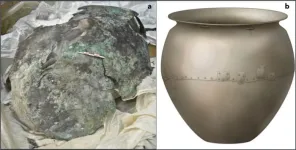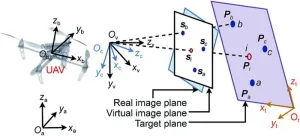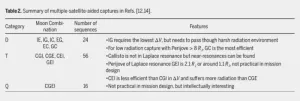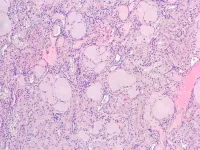(Press-News.org) Archaeologists have long been drawing conclusions about how ancient tools were used by the people who crafted them based on written records and context clues. But with dietary practices, they have had to make assumptions about what was eaten and how it was prepared. A new study published in the journal iScience on August 18 analyzed protein residues from ancient cooking cauldrons and found that the people of Caucasus ate deer, sheep, goats, and members of the cow family during the Maykop period (3700–2900 BCE).
“It’s really exciting to get an idea of what people were making in these cauldrons so long ago,” says Shevan Wilkin of the University of Zurich. “This is the first evidence we have of preserved proteins of a feast—it's a big cauldron. They were obviously making large meals, not just for individual families.”
Scientists have known that the fats preserved in ancient pottery and the proteins from dental calculus—the hard mineralized plaque deposits on the teeth—contain traces of the proteins ancient people consumed during their lives. Now, this study combines protein analysis with archaeology to explore specific details about the meals cooked in these particular vessels. Many metal alloys have antimicrobial properties, which is why the proteins have been preserved so well on the cauldrons. The microbes in dirt that would normally degrade proteins on surfaces such as ceramic and stone are held at bay on metal alloys.
“We have already established that people at the time most likely drank a soupy beer, but we did not know what was included on the main menu,” says Viktor Trifonov of the Institute for the History of Material Culture.
The researchers collected eight residue samples from seven cauldrons that were recovered from burial sites in the Caucasus region. This region sits between the Caspian and Black Seas spanning from Southwestern Russia to Turkey and includes the present-day countries Georgia, Azerbaijan, and Armenia. They successfully retrieved proteins from blood, muscle tissue, and milk. One of these proteins, heat shock protein beta-1, indicates that the cauldrons were used to cook deer or bovine (cows, yaks, or water buffalo) tissues. Milk proteins from either sheep or goats were also recovered, indicating that the cauldrons were used to prepare dairy.
Radiocarbon dating allowed the researchers to specifically pinpoint that the cauldrons could have been used between 3520–3350 BCE. This means that these vessels are more than 3,000 years older than any vessels that have been analyzed before. “It was a tiny sample of soot from the surface of the cauldron,” says Trifonov. “Maykop bronze cauldrons of the fourth millennium BC are a rare and expensive item, a hereditary symbol belonging to the social elite.”
Although the cauldrons show signs of wear and tear from use, they also show signs of extensive repair. This suggests that they were valuable, requiring great skill to make and acting as important symbols of wealth or social position—perhaps a little like Le Creuset or Mauviel saucepans today.
The researchers would like to explore similarities and differences in the residues from a wider range of vessel types. “We would like to get a better idea of what people across this ancient steppe were doing and how food preparation differed from region to region and throughout time,” says Wilkin. Since cuisine is such an important part of culture, studies like this one may also help us to understand the cultural connections between different regions.
The methods used in this study have shown that there is great potential for this new approach. “If proteins are preserved on these vessels, there is a good chance they are preserved on a wide range of other prehistoric metal artifacts,” says Wilkin. “We still have a lot to learn, but this opens up the field in a really dramatic way.”
###
This work is supported by the University of Zurich and the European Research Council (ERC) under the European Union’s Horizon 2020 research and innovation program.
iScience, Wilkin et al. “Curated cauldrons: Preserved proteins from early copper alloy vessels illuminate feasting practices in the Caucasian steppe” https://www.cell.com/iscience/fulltext/S2589-0042(23)01559-6
iScience (@iScience_CP) is an open-access journal from Cell Press that provides a platform for original research and interdisciplinary thinking in the life, physical, and earth sciences. The primary criterion for publication in iScience is a significant contribution to a relevant field combined with robust results and underlying methodology. Visit http://www.cell.com/iscience. To receive Cell Press media alerts, contact press@cell.com.
END
The US has committed to reaching net-zero emissions by 2050. To accomplish this goal, large cuts in emissions are necessary, especially in high-emission sectors like the building industry. In an article publishing on August 18 in the journal One Earth, a team of researchers use a computational model to analyze several scenarios of future building energy use in the US. They find that by tackling emissions on multiple fronts and placing focus on “demand-side measures” that affect how power is drawn from the ...
The summertime barbecue – an American tradition synonymous with celebrating freedom – may be tainted by a decidedly unfree market. A new Stanford study reveals how meat and dairy industry lobbying has influenced government regulations and funding to stifle competition from alternative meat products with smaller climate and environmental impacts. The analysis, published Aug. 18 in One Earth, compares innovations and policies related to plant-based meat alternatives and lab-grown meat in the U.S. and European Union. Its findings could help ensure ...
About The Study: The findings of this study that included 612 women suggest that adherence to preconception healthy dietary patterns before infertility treatment may be associated with a lower likelihood of pregnancy loss.
Authors: Jorge E. Chavarro, M.D., Sc.D., of the Harvard T. H. Chan School of Public Health in Boston, is the corresponding author.
To access the embargoed study: Visit our For The Media website at this link https://media.jamanetwork.com/
(doi:10.1001/jamanetworkopen.2023.29982)
Editor’s Note: Please see the article for additional information, including ...
About The Study: In a racially and ethnically diverse cohort of 34,000 adolescents, those from neighborhoods with extreme concentrations of racial and economic disadvantage were more likely to screen positive for depressive symptoms and suicidality at well-teen visits compared to their counterparts from the most racially and economically privileged neighborhoods.
Authors: Julia Acker, M.S., of the University of California, Berkeley, is the corresponding author.
To access the embargoed study: Visit our For The Media website at this link https://media.jamanetwork.com/
(doi:10.1001/jamanetworkopen.2023.29825)
Editor’s ...
About The Study: Telemedicine was rapidly adopted in skilled nursing facilities (SNFs) in early 2020 but subsequently stabilized at a low use rate that was nonetheless higher than before 2020 in this study of more than 4.4 million residents at 15,000 SNFs. Higher telemedicine use in SNFs was associated with improved access to psychiatry visits in SNFs.
Authors: Michael L. Barnett, M.D., M.S., of the Harvard T. H. Chan School of Public Health in Boston, is the corresponding author.
To access the embargoed study: Visit our For The Media website at this link https://media.jamanetwork.com/
(doi:10.1001/jamanetworkopen.2023.29895)
Editor’s ...
An estimated 1 in 4 older Americans with dementia or mild cognitive impairment lives alone and is at risk of practices like unsafe driving, wandering outside the home, mixing up medications and failing to attend medical appointments.
In a study publishing in JAMA Network Open on Aug. 18, 2023, researchers led by UC San Francisco concluded that the United States health system is poorly equipped to serve patients living solo with cognitive decline, a group whose numbers are predicted to swell as the population ages.
For these patients, living alone ...
A study published in Engineering introduces a novel image-based visual servoing (IBVS) method for unmanned aerial vehicles (UAVs) to track dynamic targets in GPS-denied environments. Titled "Dynamic Target Tracking of Unmanned Aerial Vehicles Under Unpredictable Disturbances," the research article presents a comprehensive approach that addresses the challenges of estimating target velocities, image depth estimation, and tracking stability in the presence of external disturbances.
The proposed method utilizes a constructed virtual camera to derive simplified and decoupled image dynamics for underactuated UAVs. By considering ...
The Jovian system has greatly attracted the interest of human exploration because of the important scientific value. However, Jupiter and its 4 Galilean moons form a unique and complex multi-body dynamical environment that greatly challenges trajectory design and optimization. Moreover, the extremely strong radiation environment of Jupiter and the low available fuel of spacecraft further increase the difficulty of trajectory design. In order to satisfy the requirements of diverse missions of the Jovian system exploration, develop new mission concepts, and obtain higher merit with lower cost, a variety of theories and methodologies of ...
A research group led by Dr. Tomoaki Murakami from the Tokyo University of Agriculture and Technology has revealed that fibrinogen Aα-chain amyloidosis, a previously unreported disease in animals other than humans, is highly prevalent in Japanese squirrels (Sciurus lis). In this study, they compared the pathology with that of humans, and suggested the importance of Japanese squirrels in the comparative pathological analysis of fibrinogen Aα-chain amyloidosis.
The researchers published their results on August 8th in the Journal of Pathology.
Amyloidosis is a disease group in which amyloid, generated by misfolding ...
A new study highlights the potential of artificial DNA structures that, when fitted with antibodies, instruct the immune system to specifically target cancerous cells.
Immunotherapy is viewed as an exceptionally promising weapon in the fight against cancer. In essence, the aim is to activate the body’s immune system in such a way that it identifies and destroys malignant cells. However, the destruction must be as effective and specific as possible, to avoid damaging healthy cells. A team of researchers from LMU, the Technical University of Munich (TUM) and Helmholtz Munich have now published a new study in Nature Nanotechnology in which they present ...



